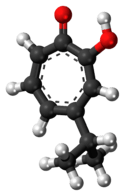Hinokitiol
| |||
| Names | |||
|---|---|---|---|
| IUPAC name
2-Hydroxy-6-propan-2-ylcyclohepta-2,4,6-trien-1-one | |||
| Other names
β-Thujaplicin; 4-Isopropyltropolone | |||
| Identifiers | |||
| 499-44-5 | |||
| 3D model (Jmol) | Interactive image | ||
| ChEBI | CHEBI:10447 | ||
| ChEMBL | ChEMBL48310 | ||
| ChemSpider | 3485 | ||
| ECHA InfoCard | 100.007.165 | ||
| KEGG | D04876 | ||
| PubChem | 3611 | ||
| |||
| |||
| Properties | |||
| C10H12O2 | |||
| Molar mass | 164.20 g·mol−1 | ||
| Appearance | Colorless to pale yellow crystals | ||
| Melting point | 50 to 52 °C (122 to 126 °F; 323 to 325 K) | ||
| Boiling point | 140 °C (284 °F; 413 K) at 10 mmHg | ||
| Hazards | |||
| Flash point | 140 °C (284 °F; 413 K) | ||
| Except where otherwise noted, data are given for materials in their standard state (at 25 °C [77 °F], 100 kPa). | |||
| | |||
| Infobox references | |||
Hinokitiol (β-thujaplicin) is a natural monoterpenoid found in the wood of trees in the family Cupressaceae. It is a tropolone derivative and one of the thujaplicins.[2] Hinokitiol has inhibitory effects on Chlamydia trachomatis and may be clinically useful as a topical drug.[3][4]
The name originates from the fact it was originally isolated in Taiwanese hinoki in 1936.[5] It is actually almost absent in Japanese hinoki while it is contained in high concentration (about 0.04% of heartwood mass) in Juniperus cedrus, Hiba cedar wood (Thujopsis dolabrata) and Western red cedar (Thuja plicata). It can be readily extracted from the cedarwood with solvent and ultrasonication.[6]
References
- ↑ β-Thujaplicin at Sigma-Aldrich
- ↑ Chedgy, Russell J.; Lim, Young Woon; Breuil, Colette (2009). "Effects of leaching on fungal growth and decay of western redcedar". Canadian Journal of Microbiology. 55 (5): 578–86. doi:10.1139/W08-161. PMID 19483786.
- ↑ Yamano, H; Yamazaki, T; Sato, K; Shiga, S; Hagiwara, T; Ouchi, K; Kishimoto, T (2005). "In vitro inhibitory effects of hinokitiol on proliferation of Chlamydia trachomatis". Antimicrobial Agents and Chemotherapy. 49 (6): 2519–21. doi:10.1128/AAC.49.6.2519-2521.2005. PMC 1140513
 . PMID 15917561.
. PMID 15917561. - ↑ Chedgy, Russell. Secondary metabolites of Western red cedar (Thuja plicata): their biotechnological applications and role in conferring natural durability. LAP Lambert Academic Publishing, 2010, ISBN 3-8383-4661-0, ISBN 978-3-8383-4661-8
- ↑ Murata, I.; Itô, S.; Asao, T. (2012). "Tetsuo Nozoe: Chemistry and Life". Chem Record. 12 (6): 599–607. doi:10.1002/tcr.201200024.
- ↑ Chedgy, Russell J.; Daniels, C.R.; Kadla, John; Breuil, Colette (2007). "Screening fungi tolerant to Western red cedar (Thuja plicata Donn) extractives. Part 1. Mild extraction by ultrasonication and quantification of extractives by reverse-phase HPLC". Holzforschung. 61 (2): 190. doi:10.1515/HF.2007.033.
This article is issued from Wikipedia - version of the 2/15/2016. The text is available under the Creative Commons Attribution/Share Alike but additional terms may apply for the media files.

